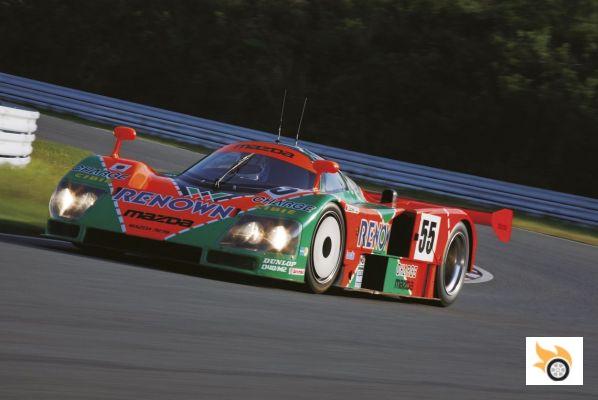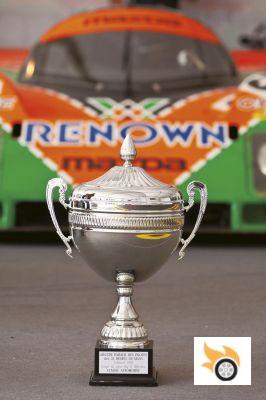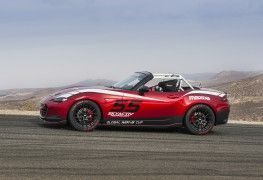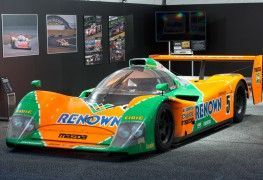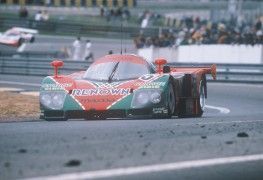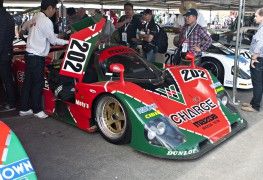These new engine regulations had been approved in 1989, with the idea of putting them into effect in 1991. De facto, the Wankel engine would be banned from the 24 Hours of Le Mans for the 1991 season. Mazda was in an extremely difficult situation: After years of investment and development, it suddenly had to either win in 1990 or abandon the rotary endurance engine project.
The firm's sporting director, Yasuo Tatsuomi, had Pierre Dieudonne's words engraved in his heart: They needed 100 more horsepower to be competitive. And they had to do it against the clock, without time for too many tests.
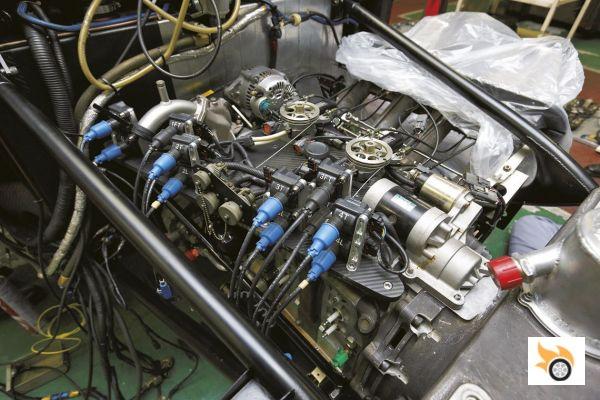
The new R26B engine delivered 700 hp and reduced fuel consumption by 10-15%.
Tatsuomi met with the project's engineers to draw up the outline of the project for the 1990 car. The 13J engine had to go from 600 to 700 horsepower. The car was to be more fuel efficient, lighter and stiffer.
The chassis, to begin with, changed its composition, becoming completely made of carbon fiber sandwich, with two tubular subframes to support the axles. The wheelbase was lengthened, the water radiator was moved to the front of the car and the front track width was reduced to improve aerodynamic penetration.
But the big star of the new 787 would be its new engine. Building on the previous year's 13J, every possible detail improvement had to be sought to increase power by the required 100 horsepower, while looking for a fuel consumption reduction of at least 10%.
To achieve its goal, the engineering team dedicated to racing engines went from eight full-time engineers to the project at the end of 1989, using the computer-aided engineering equipment used during the day to calculate production cars at night.
The 13-J experience had shown that the variable-length trumpet intake system was valid, but having two fixed positions meant that there was too much of a jump in torque delivery. The Mazda team decided to go with a continuously variable geometry system, aided by an electronic controller and a stepper motor taken from a windshield wiper. In this way, for each engine speed and throttle load there was an ideal length of intake manifold.
The fuel injection system was lowered into the intake manifold until the fuel was fed directly into the peripheral intake port, making it almost a "quasi-direct" injection system, in port. The geometry of the intake and exhaust ports was modified, which were still peripheral, as I said.
The ignition system was also modified, and now had three spark plugs, from the two of the previous engine. The addition of a third spark plug allowed a complete combustion of the mixture, making better use of the fuel supplied to the engine.
Seal and coating technology was further advanced, with ceramic hot blasting applied to the rotor rings, stator and side covers.
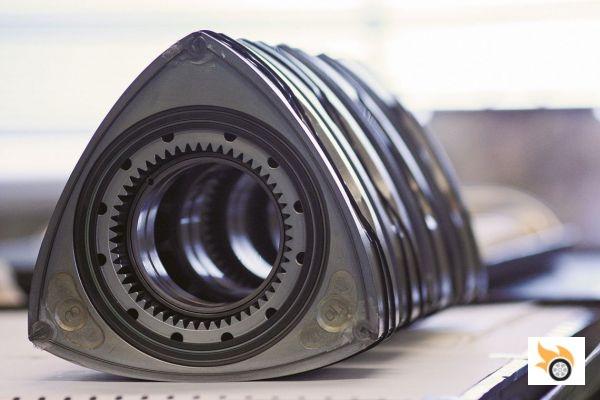
The result of all these modifications was an engine that, when first assembled, offered 703hp at 9,000 revs, and 569Nm at 7,500rpm as maximum torque. The best thing, according to the drivers, is that the torque curve extended in a usable way from 6,000 to 9,000 rpm, giving a huge margin of utilization by the standards of racing engines of the time.
In addition, the engine was slightly shorter than its predecessor, lighter and used less fuel. All the goals had been achieved. The engine was christened R26B, after its 2.6-litre displacement, just double the original 13B that had served as the basis for its development many years earlier.
The idea for 1990 was also to use the R26B as a semi-self-supporting member, adding torsional rigidity to the chassis, allowing some of the rear suspension loads to be transferred to the monocoque, something that would later prove to be a serious problem.
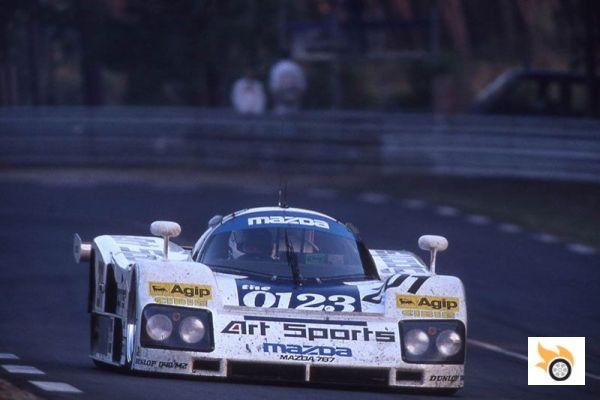
1990 Mazda 787
What Mazda didn't count on was the sudden change in track geometry. The ACO, fearful of the enormous speeds reached on the Hunaudieres straight, decided to insert two chicanes to reduce speed, which reduced the effectiveness of the 787's improvements, whose competitive advantage over its immediate predecessor had to be in the increase in straight line speed.
Le Mans 1990
With what seemed like only one chance, Mazda went all out for the win, hiring an all-star team to drive the car in 1990. Jacky Ickx was the star of the driver line-up in any case, with his six Le Mans victories behind him. Bertrand Gachot, Johnny Herbert and Volker Weidler, all with F1 experience, were to provide the necessary speed on the track.
That year's race looked promising, but things would not go as planned. For starters, the new 787s had a glaring problem at the limit, going from understeer to oversteer in fast corners unpredictably, making it difficult to get the most out of them.
The car had barely accumulated any test miles. It had completed a 24-hour test, but split over three days, and even still tested during Le Mans week to finish fine-tuning aspects of the car's aerodynamics.
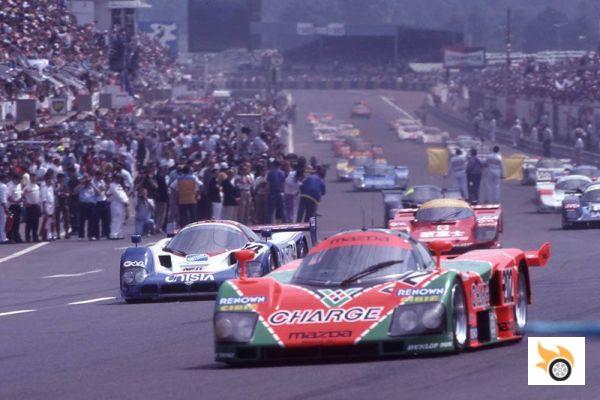
1990 proved a disaster for Mazda, with both new 787s dropping out with reliability problems.
In qualifying the car couldn't shine, and in the race both 787s present failed. The first one first encountered a rear suspension linkage failure, and after stopping to repair it, shortly after its engine failed. The steam-applied ceramic coating on the engine stator had peeled off, due to a quality defect in the engine assembly.
The other remaining 787 encountered problems with the electrical wiring system that operated the variable length trumpets, which eventually burned out due to a short circuit, putting it out of action.
As it was, Le Mans 1990 was left in the hands of a 767B driven by three Japanese drivers, who after changing the gearbox overnight, achieved 20th place in the final standings, too low a prize for Mazda's ambitions.
But some good was to come out of the week. The ACO announced a rule extension so that the Wankels and other Group C machinery could continue to be used for another year. Suddenly Mazda's disaster with the 787 had possible redemption for 1991.
So it was time to work on fixing the project's problems. Yoshinori Honiden, Mazda's sports activities coordinator at the time, decided to start working seriously on the program for 1991 and called Jacky Ickx to ask him why he thought they had failed. Ickx started working as a guru for Mazda. The first thing he explained to the Mazda manager was that the team had to complete at least two uninterrupted 24-hour tests, instead of split testing over several days, in order to make the car reliable, something Porsche had been doing for years, but Mazda had not considered. Ickx also lamented MazdaSpeed's organisational failure at Le Mans 1990, as he saw the team arriving too quickly.
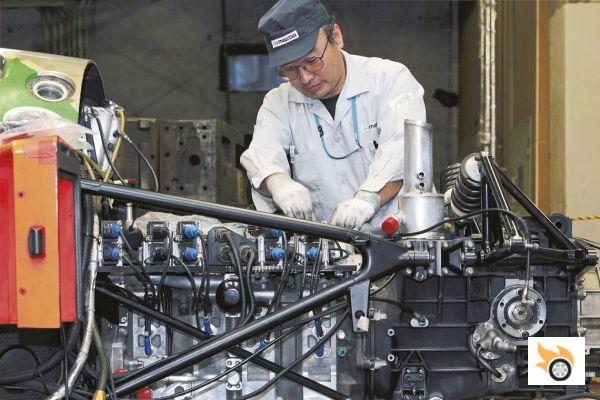
Mazda became much more involved for 1991, redesigning key parts of the chassis and engine from Hiroshima through the use of finite element technology.
Honiden also undertook work on other fronts. For starters, he wanted to address the problem of the 787 being a critical car at the limit. An analysis by Mazda engineers of the MazdaSpeed drawings made them realise that the car lacked chassis stiffness.
In the development of the RX-7, the firm was encountering a similar problem with the rear end at high speed, a problem they traced back to the realization that the monocoque lacked torsional stiffness. They asked MazdaSpeed and Nigel Stroud about the design of the rear end of the chassis, but they said the stiffness was "just right".
Mazda was not satisfied, and began a finite element (computer simulation) study of the chassis rear end stiffness, only to discover that it was clearly insufficient. To solve the problem, tie rods were designed to connect the carbon fibre monocoque to the differential and gearbox, making the car much more robust and predictable at high speed.
The second area of improvement was the application of new steel sleeves. The previous year Stroud had opted for lighter magnesium ones, but these overheated. The 787B would integrate carbon ceramic brake discs, instead of the steel ones of the 787, which would mean working at higher temperatures, so better and stronger hoses were needed, which were designed by finite elements in Hiroshima directly. Also, for the undercarriage, new 18-inch Dunlop tyres were created to improve the ground contact surface.
Finally there was the issue of the engine. Faced with the problems of ceramic coating and the manufacture of rotor apex seals, which were ordered from external suppliers, Mazda decided to set up its own production capacity to make these treatments and seals, which allowed it to create a new double ceramic coating technology that allowed the engine consumption to be reduced to 51.2 liters per 100 kilometers in race conditions, something very respectable, and that would make the difference in La Sarthe, as it would be seen later. In fact, the technology of the seals would be "imported" internally from the 13B-REW, the engine of the RX-7 FD.
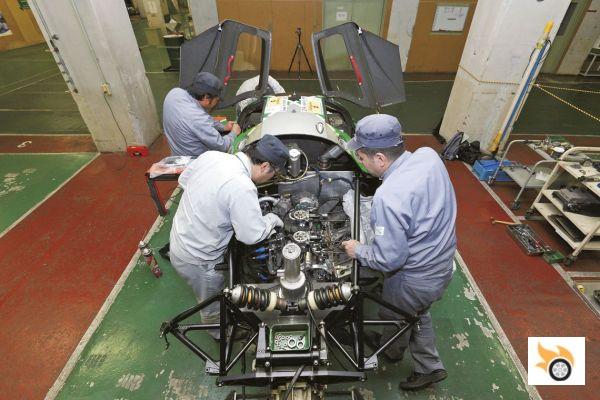
The use of predictive simulations allowed Mazda to map out a route time to win Le Mans by controlling the actual fuel burn at each instant.
However, one of Mazda's engineers had created a roadmap to win Le Mans 1991. This included a seven-second average lap time reduction. 4.8 seconds had to come from chassis improvements (new brakes and reinforced chassis), 3.2 seconds had to come from improvements to the engine seals, and the car had to spend over an hour and a quarter in the pits between repairs, refuelling and wheel changes.
Mazda also managed to develop its own race strategy prediction software. The system consisted of a simulator (typical in racing today, but not back then), which could predict fuel consumption and race pace, and also set "target" times for each section of the track. With this software, after talking to the drivers, it was possible to predict how to win Le Mans, by controlling how much throttle to apply. In fact, the best strategy for victory was to not touch the throttle in a corner, letting the car roll from braking to the apex without touching the right pedal. The fuel saving of not having that "stabilization" throttle touch might seem insignificant on one lap, but throughout the whole race it would be vital.
After so many tests, trials and evolutions, the upgraded Mazda 787B and the team were ready to attack Le Mans.
Le Mans 1991, the victory
Mazda decided to field three cars, two operated by Mazda (a 787 and a 787B), and one operated by Oreca. The firm was clear about the pace to win: They had to complete 367 laps on the fuel available, and victory would be within their grasp. It was a key and clear approach, which would be constantly monitored from the pits via telemetry and the management of the new simulation software.
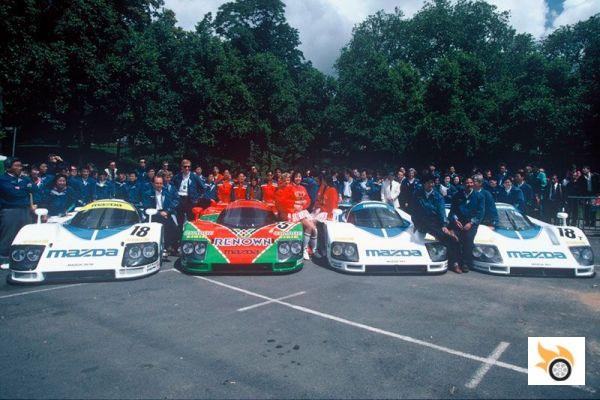
Mazda lined up three cars, two 787Bs (one for them, one for Oreca) and a "normal" 787 to ensure reliability "just in case", plus a mule.
Mazda also took a fourth car with them, as a crutch, in case something serious happened, which also served to show that they had listened to Ickx when it came to organising things better.
As a team, one car would start as the hare (the new 787B #55 of B. Gachot / J. Herbert / V. Weidler) while the other car, the previous year's improved Mazda-operated 787, the #56 of T. Yorino / Y. Terada / P. Dieudonne, would play the trick of being a bit further back, looking for reliability to make sure they would finish the race. Oreca would also go for fire with the other 787B available, but without crossing opinions or data with Mazda during the race, unless necessary.
In qualifying, with plenty of rain, the other teams couldn't clearly see what Mazda had on their hands, but the new 787B was already much faster than last year's "conventional" 787. Five seconds was the difference. As qualifying was held in the wet, the times used to set the starting grid were those of the previous practice day, so the 787B was even less impressive. It seemed that the race would be between Mercedes-Benz, Jaguar, Porsche and Peugeot, with Mazda as a partner.
The problem with the grid configuration was that, in order to promote the three and a half litre cars that would be compulsory from 1992 onwards, FISA (the germ of today's FIA) decided to award the cars in that category with the first ten places on the grid, which put Peugeot on pole (a French thing?) even though the fastest car in practice had been the Mercedes-Benz C11.
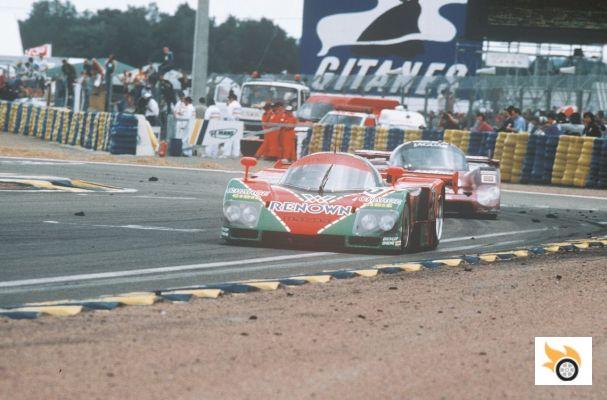
In qualifying, the 787B lapped 12 seconds slower than the Sauber Mercedes C11.
The #55 Mazda 787B started from 19th position on the grid, after having achieved the 12th fastest time in qualifying, with a 3:43.503, far from the 3:31 that the Mercedes C11 was capable of, as it had shown in qualifying.
The race was a sprint start for the Peugeots, who benefited from their grid position. The new cars were genuinely fast, but at the first pit stop they threw away all their performance, with one of the cars catching fire and an ignition problem in the second, putting them out of contention for the win immediately.
Jaguar, who were expected to have a competitive car for the early stages of the race, couldn't keep up, and Mercedes quickly made up positions to dominate the top three places in the race by 10pm. The unexpected was the #55 Mazda 787B, which unexpectedly moved into fourth place. The pace of the Mercedes was 3:40, while the Mazda was around 3:44.
Mazda had started very strong, but the data acquisition system included in the new 787B, which reported the average fuel consumption to the drivers, signed by PI, indicated that they were spending too much fuel, with an average of 1.85 kilometres per litre of fuel spent, when the race pace should be 1.91 kilometres per litre. The drivers had to slow down a bit, and managed to get into the two kilometres per litre range, applying what they had learned from the simulation program. They had to do their race and focus on their lap target: 367 laps would give them the win, and that was possible with that consumption at that pace, if nothing went wrong.
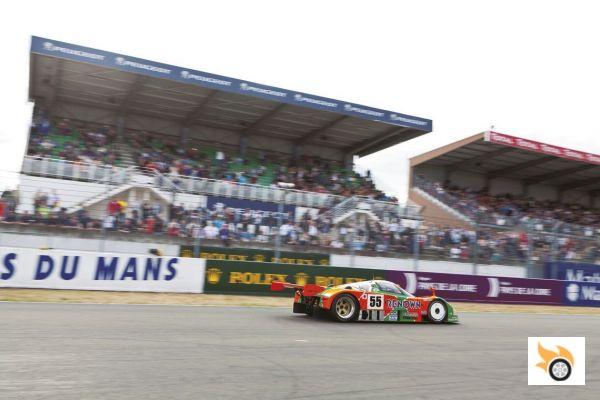
With the Peugeots eliminated, and Jaguar with fuel consumption problems, the race became a war between the three Mercedes and the Mazda.
Seeing what was happening in the race, Mazda decided to go for it. They instructed their drivers of the #55 car to go "as hard as they could", but always respecting the fuel consumption limit, and the cornering technique. By saving fuel in the corners, the car could be pushed to the limit.
At four o'clock in the morning, the first Sauber Mercedes, driven by Palmer / Dickens / Thim Sauber, had to stop for more than half an hour to replace the underbody of the car after puncturing it and breaking it with gravel in a small run off the track. The Mazda moved up to third.
Less than an hour later the Sauber Mercedes of Wendlinger / Schumacher / Kreutzpointer started to experience gearbox problems. Despite stopping several times to try to fix the problem without changing the gearbox, in the end they had no choice and the car spent three quarters of an hour in the pits.
The 787B #55 was already in second position, and only had a Mercedes ahead of him to separate him from the victory. With 4 laps to go, at dawn, the Mercedes seemed to have the race under control, lapping in the order of five seconds per lap faster than the Hiroshima car, until the car's alternator seized, causing the water pump to fail and cook the engine, which was enveloped in a dense smoke screen as it pitted.
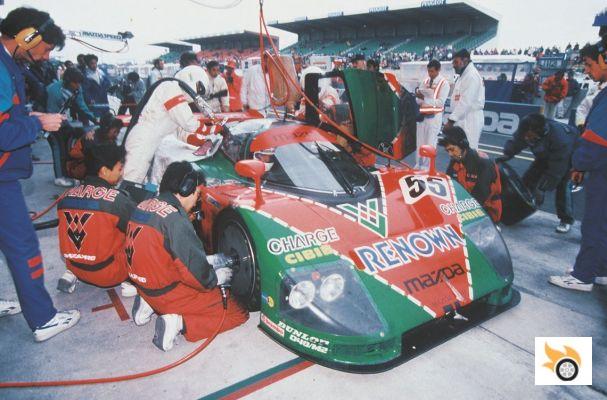
With three hours to go, the three Sauber Mercedes were eliminated from the fight for victory, and the #55 Mazda just had to manage its lead over the Jaguars to score an epic win.
The Mercedes dropped out with three hours to go, and Mazda now only had to worry about TWR's Jaguar, which was chasing some distance behind. The problem for TWR was that the engine they were using, a 7.4 litre V12, was using too much fuel, and pushing the pace to catch the 787B meant going over the limit and not being able to finish the race. Mazda simply had to control the race, and they did so masterfully.
The crowd went wild, cheering the Mazda on for the last three hours of the race, carrying it on their wings, thrilled by the idea that the underdog, the car no one expected to win, was on the verge of an epic victory, the first by a Japanese car, and the first by a car with an engine other than the traditional Otto cycle.
After completing 362 laps (five laps less than planned according to the team's original strategy, and even while saving risks and fuel), the #55 787B crossed the finish line. Gachot, Herbert and Weidler had made history.
Perhaps the most shocking thing is not the fact of the achievement itself, but that Mazda managed to do it "at the last attempt". The fact is that 1992, as we said above, would force the Hiroshima-based company to pull its Wankel out of Le Mans. But he said goodbye in style, achieving something that no one else has been able to match in Japan.
A victory that changed the way people in the West looked at Mazda.
